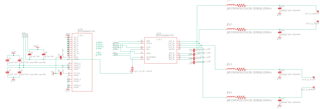Hello,
while evaluating my design, I experienced that up to 18V it is okay to drive the PMT-37N28AL01-04 speaker with ferrite bead output filters. Though I am not able to drive the IC with 24V, because it would then develope too much heat. Would LC-filters increase the performance regarding thermals, or is it simply the low impedance of the speaker?
Is there any setting in the IC that I could change in order to increase thermal performance? If not, is there an IC with built in DSP that could handle my use case better?
Use case:
Ferrite Bead output filter (lowest possible footprint)
24 V PVDD
5 W RMS and 10-15 W max per channel
4 Ohm DC resistance speaker
4 Layer PCB
-
Ask a related question
What is a related question?A related question is a question created from another question. When the related question is created, it will be automatically linked to the original question.

